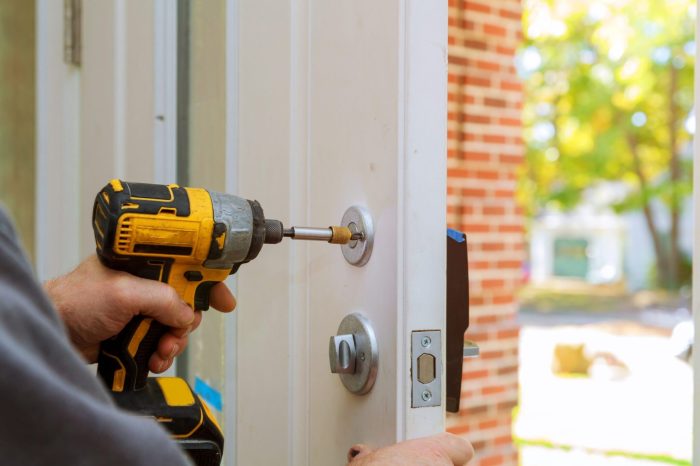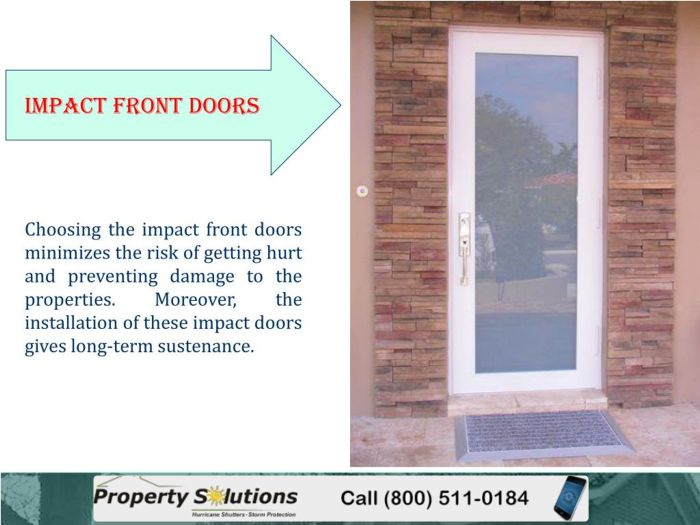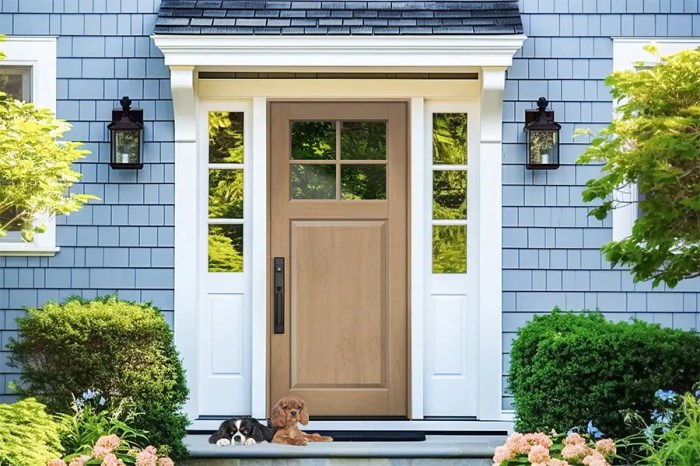Secure Front Door Installation Tips for Every Climate: Enhancing Home Safety
Embark on a journey to discover the best practices for securing your front door in any climate. From extreme temperatures to coastal regions, these tips will ensure your home stays safe and protected.
Exploring different materials, weatherproofing techniques, locking systems, and installation tips, this guide covers all you need to know for a secure front door installation.
Importance of Secure Front Door Installation
Properly installing a secure front door is crucial for the safety and security of your home. A secure front door acts as the first line of defense against intruders, protecting your property and loved ones.
Potential Risks of an Insecure Front Door
An insecure front door in different climates can pose various risks. In warmer climates, a poorly installed door may expand and contract, leading to gaps that can be exploited by burglars. In colder climates, a drafty door can not only compromise security but also result in higher energy bills.
Enhancing Home Safety with Secure Front Door Installation
- Choose a high-quality, sturdy front door made of durable materials such as steel or solid wood.
- Ensure proper installation by hiring a professional to avoid any gaps or weak points that could be targeted by intruders.
- Consider adding additional security features such as deadbolts, smart locks, or security cameras to further enhance the safety of your home.
- Maintain your front door regularly to ensure it remains in optimal condition and continues to provide reliable security.
Considerations for Front Door Material Selection
When choosing a front door for your home, it is essential to consider the material used. Different materials offer varying levels of durability, security, and maintenance requirements. Let's explore some common options for front door materials and their suitability for various climates.
Steel Doors
Steel doors are known for their strength and durability, making them an excellent choice for security. They are resistant to warping, cracking, and rotting, making them suitable for harsh climates. However, steel doors can be prone to dents and scratches, requiring periodic maintenance to prevent rust.
Fiberglass Doors
Fiberglass doors are another popular choice due to their energy efficiency and low maintenance requirements. They are resistant to dents, scratches, and warping, making them ideal for humid or coastal climates. Fiberglass doors can mimic the look of wood without the same level of maintenance.
Wooden Doors
Wooden doors offer a classic and timeless look that can enhance the curb appeal of your home. While wood is a natural insulator, providing excellent energy efficiency, it requires more maintenance than steel or fiberglass. Wooden doors are susceptible to warping, rotting, and insect damage, especially in humid or rainy climates.Consider your climate, security needs, and maintenance preferences when selecting the material for your front door to ensure it provides the desired level of durability and security for your home.
Weatherproofing Techniques for Front Doors
Weatherproofing your front door is essential to protect it from extreme temperatures and ensure energy efficiency in your home. Proper weatherproofing can help seal gaps and cracks, preventing drafts and heat loss. Let's explore some effective techniques for weatherproofing front doors.
Sealing Gaps and Cracks
- Inspect the door frame for any gaps or cracks that may allow air leaks.
- Use caulk to seal any gaps between the door frame and the wall.
- Apply weatherstripping around the door to create a tight seal and prevent air infiltration.
Importance of Weather Stripping
- Weather stripping helps to seal the gaps between the door and the frame, preventing air leaks.
- Choose weather stripping materials that are suitable for your climate to ensure durability and effectiveness.
- Regularly check and replace weather stripping to maintain its efficiency over time.
Thresholds for Different Climates
- Thresholds provide a barrier against water infiltration and help maintain a consistent indoor temperature.
- Select thresholds that are appropriate for the climate in your area, considering factors like humidity and temperature fluctuations.
- Ensure that thresholds are properly installed and sealed to maximize their effectiveness in weatherproofing your front door.
Locking Systems and Security Measures

When it comes to securing your front door, the type of locking system you choose plays a crucial role in keeping your home safe
Types of Locking Systems
- Deadbolts: These are one of the most secure types of locks and provide an additional layer of protection to your front door.
- Keyless Entry Systems: Utilizing smart lock technology, keyless entry systems offer convenience and enhanced security by allowing you to control access to your home remotely.
- Double Cylinder Locks: These locks require a key to open from both the inside and outside, adding an extra level of security against break-ins.
Smart Lock Technology
Smart lock technology has revolutionized home security by offering keyless entry, remote access control, and real-time monitoring of your front door. With features like smartphone integration and activity logs, smart locks provide convenience and peace of mind.
Additional Security Measures
- Deadbolts: Installing a deadbolt in addition to your primary lock can significantly increase the security of your front door.
- Door Chains: Door chains allow you to partially open the door for communication while maintaining a level of security.
- Peepholes: A peephole enables you to see who is at your door without compromising your safety by opening it to strangers.
Installation Tips for Different Climates
Installing a front door requires careful consideration of the climate conditions in your area. Different climates can impact the installation process and the overall security of your door. Here are some tips specific to various climates:
Hot Climates
In hot climates, doors may expand and contract due to extreme temperatures. To ensure a secure installation:
- Choose a material that can withstand high temperatures without warping, such as fiberglass or metal.
- Use weather-stripping to prevent hot air from entering your home and to maintain a comfortable indoor temperature.
- Consider installing a storm door for added protection against heat and UV rays.
Cold Climates
Cold climates can cause doors to shrink and create gaps that compromise security. To address this issue:
- Opt for a door material like wood or fiberglass that provides good insulation against cold weather.
- Use a door sweep to seal any gaps at the bottom of the door and prevent drafts.
- Consider adding a door canopy or awning to protect your door from snow and ice buildup.
Humid Regions
In humid areas, moisture can lead to rot, mold, and rust on doors. To protect your door in humid climates:
- Choose a material like vinyl or aluminum that is resistant to moisture and corrosion.
- Apply a waterproof sealant to your door to prevent water damage and maintain its integrity.
- Regularly inspect and maintain your door to address any signs of water damage promptly.
Coastal Areas
Coastal regions are prone to salt air and high humidity, which can accelerate corrosion on doors. To ensure your front door withstands coastal conditions:
- Opt for a door material like fiberglass or stainless steel that is resistant to rust and corrosion.
- Apply a marine-grade finish or coating to protect your door from salt air and moisture.
- Regularly clean and rinse your door to remove salt residue and prevent corrosion buildup.
Closing Notes
With these comprehensive tips and strategies, you can now confidently enhance the security of your home with a secure front door installation tailored to every climate. Stay safe and secure with these valuable insights.
Q&A
What are the potential risks of having an insecure front door in different climates?
Leaving your front door insecure can make your home vulnerable to break-ins, extreme weather damage, and energy loss.
Which front door material is most suitable for hot climates?
For hot climates, fiberglass is an excellent choice due to its durability and resistance to warping.
What are some additional security measures to consider apart from locking systems?
Installing deadbolts, door chains, and peepholes can add extra layers of security to your front door.




